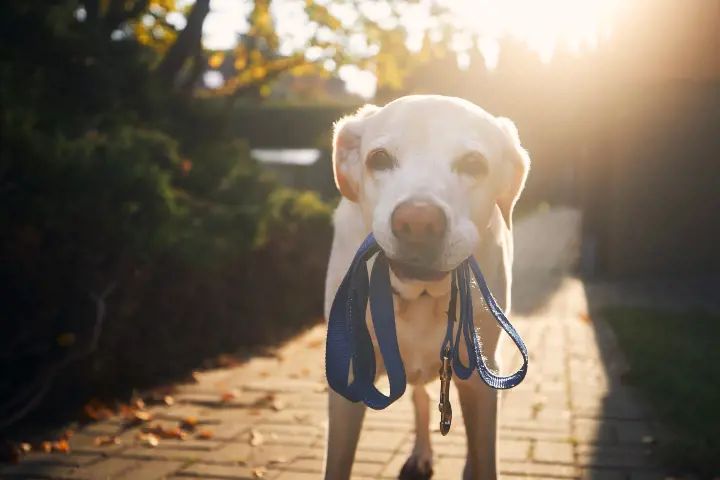Understanding the signs of heat stroke in dogs
15th August, 2023

As an attentive dog parent, it’s advised that you to be well-versed in the signs of heat stroke in dogs. Heatstroke in dogs is a potentially lethal condition that can occur in our beloved four-legged friends if they become too hot and are unable to reduce their body temperature.
As the mercury rises, it's important to keep in mind that dogs don't sweat like we do. They primarily cool down by panting, and in extreme temperatures, panting may not be enough to keep their body temperature in check.
In some cases, heat stroke can occur in dogs even on warm days, that don't seem excessively hot to you. This happens because dogs, especially those with thick coats or those that are overweight, can overheat easily.
Dogs with shorter noses, such as bulldogs and pugs, are also more susceptible to heat stroke. Therefore, understanding the signs of heat stroke in dogs is a suggested aspect of responsible dog ownership.
Bear in mind that prevention is always better than cure. By taking some simple precautions, you can help keep your dog safe from this potentially fatal condition. But first, let's delve into what exactly heat stroke is.
Understanding what exactly heat stroke is
Heat stroke in dogs is a condition caused by an elevated body temperature, usually due to prolonged exposure to or physical exertion in hot temperatures. This elevated body temperature leads to physiological changes that can result in damage to the body's cellular system, leading to multiple organ dysfunction, or even death.
It is important to differentiate between heat exhaustion and heat stroke. Heat exhaustion is a precursor to heat stroke and is characterised by heavy panting, rapid pulse, and high body temperature. If not addressed promptly, heat exhaustion can escalate to heat stroke, which is a medical emergency.
Veterinary experts classify heat stroke as a temperature of 40°C or higher. At this temperature, the body's normal cooling mechanisms can't keep up, and the dog's body temperature starts to rise uncontrollably. This is where the knowledge of signs of heat stroke in dogs becomes an essential tool for every dog owner.
Common signs of heat stroke in dogs
The early signs of heat stroke in dogs can be subtle but escalate quickly. The most common signs include:
- Excessive panting and salivating
- Fatigue or disorientation
- Increased heart rate
- Discomfort
- Restlessness
As the condition progresses, your dog may start to drool excessively and become unsteady on their feet. They may also develop diarrhoea or vomiting, which can sometimes be bloody.
More severe signs include:
- A bright red tongue and gums
- Increased body temperature (over 39°C)
- Rapid heart rate
- Laboured breathing
It's worth noting that these symptoms can also be indicative of other health problems, so it's always advised to seek veterinary attention if your dog is showing these signs. This is particularly true in hot weather or if your dog has been in a hot environment or has been exercising strenuously.
Serious signs of heat stroke in dogs in the UK
In the UK, the signs of heat stroke in dogs can be even more severe due to the sudden change in weather conditions. Heat stroke can cause seizures, collapse, unconsciousness, or even death.
One of the most severe signs of heatstroke is a change in gum colour, which may turn a dark red, purple, or blue, indicating a serious lack of oxygen.
If your dog shows any of these signs after being exposed to heat, it is critical that you act immediately. Remove your dog from the heat, try to cool them down, and get them to the vet as soon as possible.
Keep in mind that even if your dog seems to recover, it is still important to take them to the vet, as there may be internal damage that is not immediately apparent. Remember, the faster the treatment, the better the outcome will be.
Causes of heat stroke in dogs
Heat stroke in dogs can occur for a variety of reasons. The most common is prolonged exposure to high temperatures, particularly without access to shade, air conditioning or fresh water.
However, heat stroke can also occur if a dog is left in a car on a hot day, even with the windows slightly open, as the temperature inside a car can rise rapidly.
Overexertion during exercise can also cause heat stroke, especially in brachycephalic breeds (those with short noses and flat faces), overweight dogs, and those with thick or dark-coloured coats. Dogs with certain medical conditions, such as laryngeal paralysis or heart disease, are also at increased risk.
Prevention of heat stroke in dogs

The key to preventing heat stroke in dogs is to keep them cool and hydrated. Always provide access to fresh, cool water and shade, particularly on hot summer days.
Avoid exercising your dog during the hottest parts of the day, and never leave your dog in a car on a warm day, even for a short period of time. For more tips on how to take care of your dog on hot days, check out our ultimate guide to warm weather for pets.
Consider using cooling mats or fans to help keep your dog comfortable. Regular grooming can also help, particularly in warm weather, for dogs with thick coats.
If your dog is at high risk for developing heat stroke, - such as brachycephalic breeds, elderly dogs, or those with medical conditions - extra precautions may be necessary. Talk to your vet about the best ways to keep your dog cool and safe.
What to do if your dog shows signs of heat stroke
If your dog shows signs of heat stroke, it's important to act fast. Move your dog to a cooler area immediately. Start cooling your dog's temperature back down by offering small amounts of water to drink.
Do not use ice or very cold water, as this can cause the blood vessels to constrict, slowing down the cooling process and potentially leading to shock. Instead, use a fan to move cool air to help evaporate the water and cool your dog down.
Once you've started these cooling measures, get your dog to the vet as soon as possible. Even if they seem to be recovering, heat stroke can cause internal damage that isn't immediately apparent.
Treatment for heat stroke in dogs
Treatment for heat stroke in dogs typically involves lowering the dog's body temperature and managing any complications, such as dehydration or organ damage. This may involve intravenous fluids, oxygen therapy, and medications to prevent or treat damage to the heart, brain, and other organs.
In severe cases, hospitalization may be necessary. The prognosis for dogs with heat stroke varies widely, depending on the severity of the condition and the speed of treatment.
The long-term effects of heat stroke in dogs
Heat stroke can have long-term effects on a dog's health. It can cause damage to the brain, heart, kidneys, and other organs, and in some cases, this damage can be permanent. It can also increase a dog's susceptibility to heat stroke in the future.
Recovering from heat stroke can take time, and your dog may require ongoing treatment and monitoring. Regular follow-up appointments with your vet will be necessary to monitor your dog's progress and manage any ongoing issues.
Conclusion
The signs of heat stroke in dogs are something that every dog owner should be familiar with. Understanding these signs and acting quickly can save your dog's life. Remember, prevention is always better than cure, so take steps to keep your dog cool and comfortable, particularly during the warmer months.
To ensure your furry friend is covered in case of emergencies, consider pet insurance. To get a pet insurance quote for your furry friend you can get a quote through our website by clicking here. If you would like to talk to one of our pet insurance team, you can get in touch with us on 0330 102 5748.
Helpful Pages
Recent Posts
Pet Insurance Quote
- 98% claims paid *
- Claims paid directly to vets
- 24/7 vet video consultations
- Interest free monthly payments




